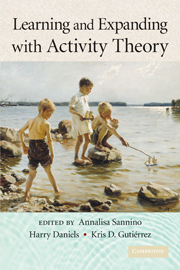Book contents
- Frontmatter
- Contents
- Contributors
- Editors' introduction
- 1 Activity Theory Between Historical Engagement and Future-Making Practice
- PART ONE UNITS OF ANALYSIS
- PART TWO MEDIATION AND DISCOURSE
- PART THREE EXPANSIVE LEARNING AND DEVELOPMENT
- PART FOUR SUBJECTIVITY, AGENCY, AND COMMUNITY
- PART FIVE INTERVENTIONS
- 16 Who Is Acting in an Activity System?
- 17 Past Experiences and Recent Challenges in Participatory Design Research
- 18 Clinic of Activity: The Dialogue as Instrument
- 19 The Future of Activity Theory: A Rough Draft
- Bibliography
- Author Index
- Subject Index
19 - The Future of Activity Theory: A Rough Draft
Published online by Cambridge University Press: 05 June 2012
- Frontmatter
- Contents
- Contributors
- Editors' introduction
- 1 Activity Theory Between Historical Engagement and Future-Making Practice
- PART ONE UNITS OF ANALYSIS
- PART TWO MEDIATION AND DISCOURSE
- PART THREE EXPANSIVE LEARNING AND DEVELOPMENT
- PART FOUR SUBJECTIVITY, AGENCY, AND COMMUNITY
- PART FIVE INTERVENTIONS
- 16 Who Is Acting in an Activity System?
- 17 Past Experiences and Recent Challenges in Participatory Design Research
- 18 Clinic of Activity: The Dialogue as Instrument
- 19 The Future of Activity Theory: A Rough Draft
- Bibliography
- Author Index
- Subject Index
Summary
In a previous attempt to outline the challenges facing cultural-historical activity theory, I observed two opposite tendencies in our field:
One force pulls researchers toward individual applications and separate variations of certain general, often vague ideas. The other force pulls researchers toward learning from each other, questioning and contesting each other's ideas and applications, making explicit claims about the theoretical core of the activity approach. (Engeström, 1999a, p. 20)
This volume is a welcome example of the second tendency. I see it as a formative intervention, a virtual Change Laboratory (Engeström, 2007e), attended by a diverse group of scholars interested in pushing forward the development of activity theory. Looking at this effort through Vygotsky's (1997b) idea of double stimulation, the first stimulus or “problem space” for the contributors was the body of research and theorizing I have produced over the years. The second stimulus consisted of the critical reviews written by other authors and colleagues.
However, the resulting chapters are not merely commentaries on my work. Double stimulation is an expansive method. It pushes the subject to go beyond the problem initially given, to open up and expand on an object behind the problem. In this case, the object is activity theory, embedded in its relations to other theories and to the societal reality it tries to grasp and change.
- Type
- Chapter
- Information
- Learning and Expanding with Activity Theory , pp. 303 - 328Publisher: Cambridge University PressPrint publication year: 2009
- 155
- Cited by

